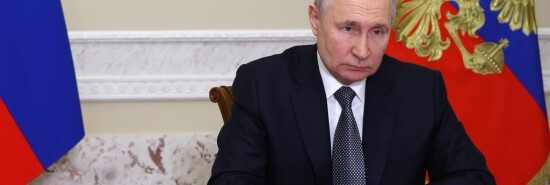
Russia’s eastern neighbors monitor its decline
Janusz Bugajski
Russia’s war in Ukraine is taking a major toll on its military, finances, and resources. It is also further depopulating far-flung regions of Siberia and the Far East, which are already sparsely settled. The accelerating decline will encourage neighboring states to intervene either to assist kindred populations, gain access to resources, or regain territories forfeited to Russia’s empire.
According to new official statistics, the population of Russia’s Siberian and Far East districts, with a territory larger than Europe, declined by almost 1 million people between 2010 and 2022 to a total population of under 25 million. This trend is quickening amid falling birth rates, rising death rates, and increasing outmigration. Moscow is unable to attract settlers from core Russia to its distant regions, which are experiencing infrastructural decay and shortages of goods and amenities. Moscow’s control is further weakened by a shrinking ethnic Russian population in proportion to non-Russians.
PENTAGON MUST REJECT ABSURD F-35 PERFORMANCE-BASED LOGISTICS CONTRACT
Economic decline and instability will have an impact on all neighboring countries. A total of 35 Russian republics and regions share a land border or a narrow sea frontier with 14 foreign countries. Long-standing historical, ethnic, and religious links will encourage several neighboring states to play a more prominent role in kindred regions. Some capitals may also recognize emerging political entities as independent states and even push for unification. Three countries in particular will be pulled into Russia’s malaise: China, Mongolia, and Japan.
Bids for sovereignty by republics and regions in Siberia and along the Pacific Coast will encourage Chinese irredentism and potential conflicts both with Moscow and with regionalist movements. There is a growing probability of Chinese territorial encroachment into Russia’s sparsely populated regions north of the Amur River and east of the Ussuri River. These “lost territories” are depicted as Chinese on Beijing’s military maps. Territorial aspirations will also be driven by huge population disparities, with over 130 million inhabitants in three Chinese provinces bordering Russia’s Far Eastern regions that have a combined population of under 8 million. Beijing will need more agricultural land, energy, natural resources, and urban living space to accommodate its citizens. If it cannot achieve this through treaties with Moscow, it is likely to act more forcefully as Russia weakens.
Mongolia will become involved in Russia’s rupture as support for a federal pan-Mongol state can be revived in southern Siberia to include the Buryat Republic, the Tuva Republic, and parts of two other regions with significant Buryat Mongol populations. Pan-Mongol nationalists will seek to amalgamate Buryat and Tuvan territories with Mongolia itself, while many Tuvans and Buryats view themselves as distinct ethnic groups entitled to their own national states.
Border disputes between Russia and Japan revolve around the southern Kuril Islands and latent Japanese claims to the southern part of Sakhalin Island. After Japan’s military victory over Russia in 1905, half of Sakhalin was ceded to Tokyo. The Soviet Union seized the entire island, as well as all the Kuril Islands, in the closing stages of World War Two. Although Moscow agreed in principle to return the two smaller south Kuril Islands of Shikotan and Habomai to Japan, the government in Tokyo views this as insufficient to resolve the long-standing dispute.
Moscow is concerned about potential Japanese moves to regain the Kurils, as the Russian fleet and air force may not be prepared to resist a larger and more capable Japanese military. The islands are largely undefended, and spreading territorial fractures in Russia can tempt Tokyo to take the initiative and forcefully regain its historical territories. More ambitious political forces in Japan can also act on latent claims to Sakhalin and parts of the Kamchatka Peninsula, where Japanese colonization predates Russian penetration. As historical grievances are unearthed throughout Siberia and the Far East, a vulnerable Russia will become an increasingly contested territory.
CLICK HERE TO READ MORE FROM THE WASHINGTON EXAMINER
Janusz Bugajski is a senior fellow at the Jamestown Foundation in Washington, D.C. His recent book is Failed State: A Guide to Russia’s Rupture. His next book is titled Pivotal Poland: Europe’s Rising Strategic Player.
